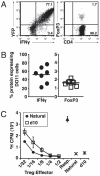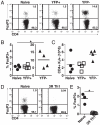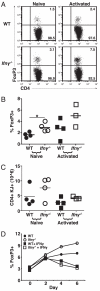Cutting edge: the Th1 response inhibits the generation of peripheral regulatory T cells
- PMID: 19949064
- PMCID: PMC2908389
- DOI: 10.4049/jimmunol.0903412
Cutting edge: the Th1 response inhibits the generation of peripheral regulatory T cells
Abstract
The possibility that effector T cells can be converted into forkhead box P3(+) regulatory T cells (Tregs) has potential therapeutic implications. To analyze the relationship between Th1 effectors and Tregs, we have used a model of systemic autoimmunity in which both effector and Tregs arise from a single population specific for a transgene-encoded systemic protein. In vitro, the presence of IFN-gamma inhibits Treg generation during activation. Using IFN-gamma reporter mice, we demonstrate that IFN-gamma-producing cells tend not to develop into Tregs, and Th1 priming of T cells prior to cell transfer limits the number of forkhead box P3(+) T cells generated in vivo. Moreover, transfer of IFN-gamma(-/-) or STAT1(-/-) T cells resulted in an increase in the number of Tregs. These data support a role for Th1 effector molecules and transcription factors in the control of peripheral Treg generation and demonstrates the limited plasticity of Th1 populations.
Figures




Similar articles
-
Atherosclerosis-Driven Treg Plasticity Results in Formation of a Dysfunctional Subset of Plastic IFNγ+ Th1/Tregs.Circ Res. 2016 Nov 11;119(11):1190-1203. doi: 10.1161/CIRCRESAHA.116.309764. Epub 2016 Sep 15. Circ Res. 2016. PMID: 27635087 Free PMC article.
-
Promoted Generation of T Helper 1-Like Regulatory T Cells After Transient Middle Cerebral Artery Occlusion in Type-2 Diabetic Mice.Immunol Invest. 2023 Nov;52(4):482-498. doi: 10.1080/08820139.2023.2197009. Epub 2023 Apr 19. Immunol Invest. 2023. PMID: 37076315
-
Regulatory T cells inhibit acute IFN-γ synthesis without blocking T-helper cell type 1 (Th1) differentiation via a compartmentalized requirement for IL-10.Proc Natl Acad Sci U S A. 2011 Nov 8;108(45):18336-41. doi: 10.1073/pnas.1110566108. Epub 2011 Oct 24. Proc Natl Acad Sci U S A. 2011. PMID: 22025707 Free PMC article.
-
Balance of Th1 and Th17 effector and peripheral regulatory T cells.Microbes Infect. 2009 Apr;11(5):589-93. doi: 10.1016/j.micinf.2009.04.012. Epub 2009 Apr 17. Microbes Infect. 2009. PMID: 19376259 Free PMC article. Review.
-
Stability of Regulatory T Cells Undermined or Endorsed by Different Type-1 Cytokines.Adv Exp Med Biol. 2015;850:17-30. doi: 10.1007/978-3-319-15774-0_2. Adv Exp Med Biol. 2015. PMID: 26324343 Review.
Cited by
-
Roles of IFN-γ in tumor progression and regression: a review.Biomark Res. 2020 Sep 29;8:49. doi: 10.1186/s40364-020-00228-x. eCollection 2020. Biomark Res. 2020. PMID: 33005420 Free PMC article. Review.
-
Prevention of EAE by tolerogenic vaccination with PEGylated antigenic peptides.Ther Adv Chronic Dis. 2021 Aug 12;12:20406223211037830. doi: 10.1177/20406223211037830. eCollection 2021. Ther Adv Chronic Dis. 2021. PMID: 34408824 Free PMC article.
-
Cell penetrable-mouse forkhead box P3 suppresses type 1 T helper cell-mediated immunity in a murine model of delayed-type hypersensitivity.Exp Ther Med. 2017 Feb;13(2):421-428. doi: 10.3892/etm.2017.4020. Epub 2017 Jan 2. Exp Ther Med. 2017. PMID: 28352310 Free PMC article.
-
Increased frequency of regulatory T cells in the peripheral blood of patients with endometrioid adenocarcinoma.Oncol Lett. 2019 Aug;18(2):1424-1430. doi: 10.3892/ol.2019.10452. Epub 2019 Jun 7. Oncol Lett. 2019. PMID: 31423207 Free PMC article.
-
iNKT Cells Suppress Pathogenic NK1.1+CD8+ T Cells in DSS-Induced Colitis.Front Immunol. 2018 Oct 2;9:2168. doi: 10.3389/fimmu.2018.02168. eCollection 2018. Front Immunol. 2018. PMID: 30333822 Free PMC article.
References
-
- Fontenot JD, Rasmussen JP, Williams LM, Dooley JL, Farr AG, Rudensky AY. Regulatory T cell lineage specification by the forkhead transcription factor foxp3. Immunity. 2005;22:329–341. - PubMed
-
- Maloy KJ, Powrie F. Regulatory T cells in the control of immune pathology. Nat. Immunol. 2001;2:816–822. - PubMed
-
- Shevach EM. CD4+ CD25+ suppressor T cells: more questions than answers. Nat. Rev. Immunol. 2002;2:389–400. - PubMed
-
- Grogan JL, Mohrs M, Harmon B, Lacy DA, Sedat JW, Locksley RM. Early transcription and silencing of cytokine genes underlie polarization of T helper cell subsets. Immunity. 2001;14:205–215. - PubMed
-
- Mullen AC, Hutchins AS, Villarino AV, Lee HW, High FA, Cereb N, Yang SY, Hua X, Reiner SL. Cell cycle controlling the silencing and functioning of mammalian activators. Curr. Biol. 2001;11:1695–1699. - PubMed
Publication types
MeSH terms
Substances
Grants and funding
LinkOut - more resources
Full Text Sources
Other Literature Sources
Molecular Biology Databases
Research Materials
Miscellaneous

